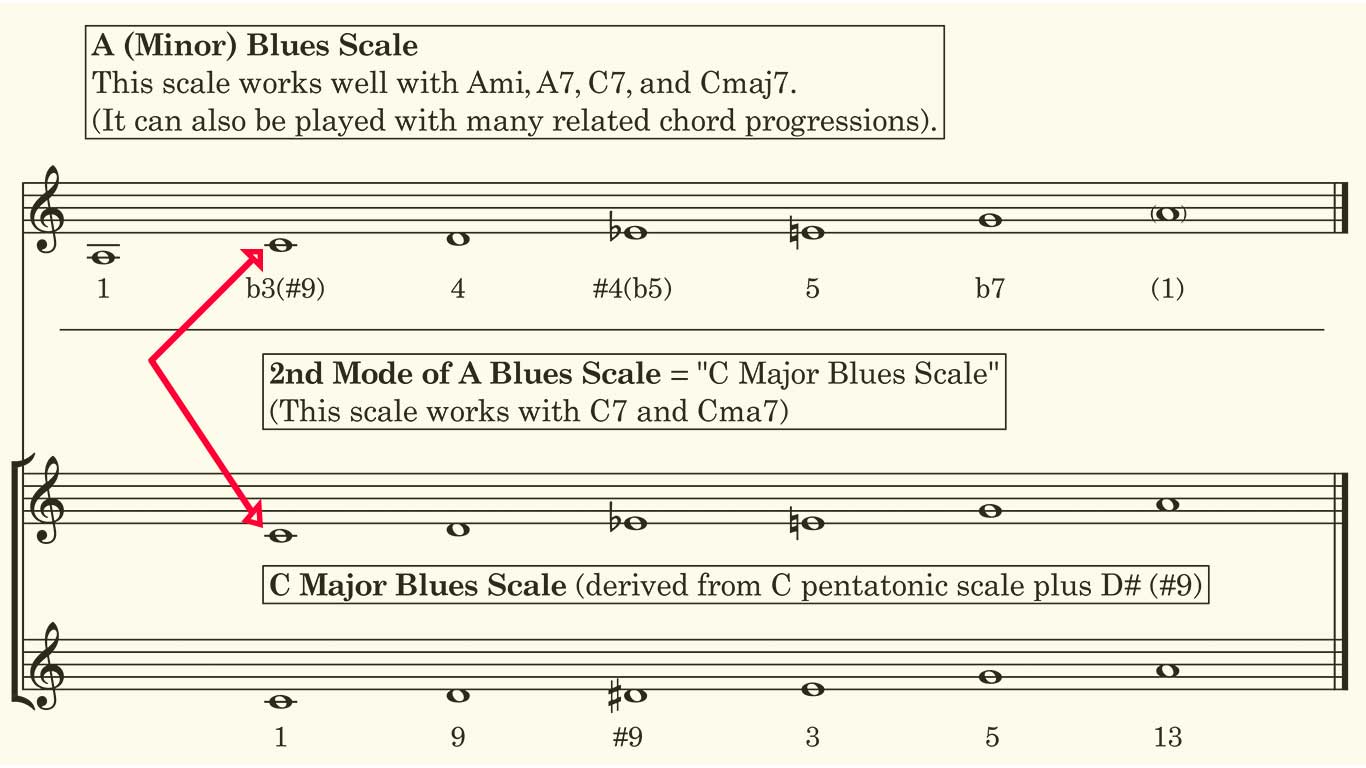What Is The Blues Scale?
Some argue that there are, in fact, two blues scales:
- The Major Blues Scale (degrees 1, 2, b3(#9), 3, 5, 6) is derived from the major pentatonic scale (1, 2, 3, 5, 6) with the inclusion of a blue note (b3=#9).
- The Minor Blues Scale (degrees 1, b3(#9), 3, 4, b5(#11), 5, b7) derived from the minor pentatonic scale (1, b3, 4, 5, b7) with an added blue note (b5=#11)
The names imply that one is only applicable to major keys while the other pertains to minor keys. In practice, however, the “minor” blues scale is frequently used for both minor and major blues. In fact, it sounds especially bluesy when played in a major blues context.
Here is a fascinating fact about the major blues scale
Did you know that the major blues scale can be seen as the second mode of the blues scale in the relative minor key? For instance, when we play the A minor blues scale over a C7 chord, beginning with the second note of the scale, we derive what is known as the C major blues scale (as illustrated below).

Major-Blues-Scale-Explained-Table
Is the Major Blues Scale a Blues Scale?
The major blues scale doesn't really sound very bluesy. That's because it lacks the notes that create the dissonance necessary to feel the blues, such as the #9 and b5, which are the "Blue Notes" of the original blues scale.
When we examine the pitches of the major blues scale, we discover that it is essentially the major pentatonic scale with a chromatic passing tone between the second and third degrees (as shown in the illustration above). While it can be played over major seventh chords, those chords typically don't convey a bluesy sound because it is much closer to the Mixolydian scale. Conversely, the minor blues scale may not pair well with major seventh chords, but in the realm of blues, almost anything goes!
Key Scales for Blues Improvisation
When listening to skilled jazz musicians play the blues, you'll observe that they employ a range of scales. Below is a table that highlights the most common scales used in blues music. I've organized it using different colors to illustrate the relationship between the major and minor pentatonic scales and the major and minor blues scales.

The final system in the table above displays the notes from all the scales combined. It’s nearly the chromatic scale, with the exceptions of #2, #5, and ∆7. And even those notes may easily be used as chromatic passing tones. It’s like, “Everything goes,” right?
Conclusion
Jazz musicians, along with more contemporary blues artists, don’t confine themselves to a single scale. The possibilities are endless. What gives music its bluesy feel involves not only blue notes but also our phrasing, rhythm, dynamics, articulations (including slides, bends, vibrato, etc.), and embellishments.
From a Pianistic Point of View
On a guitar or a horn, the player can bend notes like a singer, which is perceived as bluesy when done correctly. Playing between two pitches is essential for that bluesy sound. When playing the keyboard, we must create the illusion of bending notes. We achieve this by using grace notes, trills, playing seconds, and other techniques. Ultimately, it boils down to Blues licks. Great pianists like Albert Ammons, Dr. John, and Oscar Peterson effectively used blues licks to bring the blues to life on the piano.
